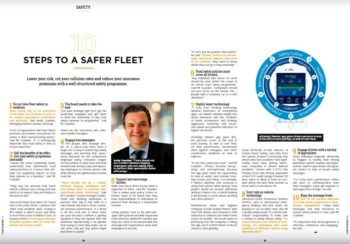Blog
10 Steps To A Safer Fleet
Originally published in Fleet Europe 4/21/2020

Lower your risk, cut your collision rates and reduce your insurance premiums with a well-structured safety programme.
1. Do not view fleet safety in isolation
Road safety has to be perceived at all levels of a business as part of its normal operational procedures and practices, said Andy Cuerden, Managing Director, Europe, eDriving.
A lot of organisations will have robust practices, procedures and policies for safety in their manufacturing plants,” said Mr Cuerden. “It is strategically important that road safety is seen as no less important.”
2. Sell the benefits of an effective road safety programme internally
“Ensure the senior leadership teams understand how detrimental road safety practices or a laissez-faire attitude can negatively impact on how they operate as a business,” said Mr Cuerden.
“They may not perceive how much vehicle collisions are costing and how much of an impact they are having on the bottom line.
“One of eDriving’s first clients, BT, found that in the early 2000s, collisions and other road incidents were costing it $25 million in direct losses and three to four times more in indirect costs. In business terms, it took approximately 600,000 product sales to cover the annual cost of fleet claims.
3. The board needs to take the lead
“Get your strategy right first, get the leadership engaged and get them to drive the ownership of any road safety initiative or programme,” said Mr Cuerden.
These are the executives who influence middle managers.
4. Engage line managers
The people who manage drivers on a day-to-day basis have a huge role to play in reinforcing safety messages and ensuring that operational demands do not compromise employee safety. Unrealistic targets for the number of client visits that staff should make during a day and expecting employees to receive phone calls while driving can significantly increase road risk.
“There should not be a conflict between keeping employees safe and asking them to perform their operational duties effectively,” said Mr Cuerden. “Ensure managers understand that allowing employees to perform their day-to-day tasks in a safe manner will lead to more consistent business performance. If a driver is off the road two or three times per year because a vehicle is getting repaired or they are injured, then the downtime operationally is far greater than trying to insist they make one or two extra calls per day, which might lead them to speed.”
5. Support and encourage drivers
Make sure every driver knows what is expected of them, said Mr Cuerden. “This is where your policy comes in. Drivers need to be aware that they have responsibilities as individuals to perform their driving in a responsible manner.”
Safety policies have to be well-managed, well-policed, and well-respected to be effective, added Mr Cuerden, but they also need to be infused with the message that organisations want their employees to be safe.
“It can’t just be policies that punish,” he said. “Drivers need to be encouraged, they need support, they need to be coached, they need to know where they can go if they need help.”
6. Road safety policies must cover all drivers
“Any individual who drives for work should be seen within the scope of an overall road safety programme,” said Mr Cuerden. “Companies should not just focus on the known risk – people with a company car or a cash allowance.”
7. Deploy smart technology
Data from tracking technology, whether telematics or smartphone apps, can deliver valuable insight into driver behaviour and risk. Incidents of hard accelerating and braking, aggressive cornering and excessive speed are powerful indicators of higher risk drivers.
eDriving’s Mentor app gives drivers personal scores at the end of each journey, as well as over time, on their performance, benchmarks them against colleagues, and offers constructive feedback on how to improve.
“It acts like a personal coach,” said Mr Cuerden. “Drivers become self-policing and self-improving because the app gives them the opportunity to look at events and contains training courses and videos. For example, if Mentor identifies that someone is using their phone while driving, their playlist would be around distracted driving. If there’s lots of harsh braking it will provide a course about avoiding rear-end collisions.”
Multinational water and hygiene company Ecolab trialled Mentor with over 500 drivers and achieved a 30% reduction in collisions per million miles in just six months. The results were so promising that the company is rolling the app out to 12,000 drivers in North America, then globally.
Sarah Bechtold, Ecolab Director of Global Driver Safety, said data from the system showed conclusively that drivers who had accidents “had significantly more risky driving behaviours compared to drivers without accidents.” Drivers with a FICO Safe Driving Score (the driving equivalent of the FICO credit rating) of below 710 were twice as likely to have an accident within the next three months as those with a score above 710.
8. Don’t rely on vehicle technology
Advanced Driver Assistance Systems (ADAS), such as autonomous emergency braking and lane assist, are helping to cut accident rates. But Mr Cuerden emphasised: “It’s still the individual’s responsibility to make sure a vehicle is being driven safely. You cannot become over reliant on technology; it’s individuals who make hundreds of difference choices every time they drive.”
9. Engage drivers with a variety of approaches
Every individual responds differently to triggers to modify their driving behaviour, said Mr Cuerden, and organisations need to give drivers the greatest chance to take on board safety messages.
“For some that’s gamification; others will react to communication from their managers; some will respond to messages from on high,” he said.
10. Keep the message fresh
One of the hardest elements of road safety programme is maintaining engagement. Using fresh messages and new resources to sustain driver interest is vital, said Mr Cuerden.
“It’s important that the programme is effective, continuous, and engaging,” he said.